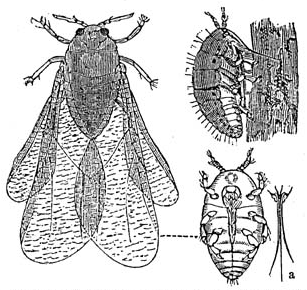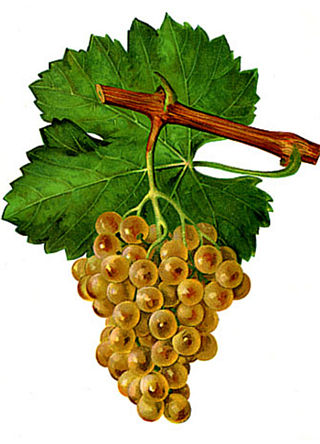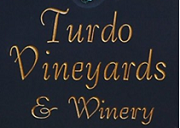
Grape phylloxera is an insect pest of commercial grapevines worldwide, originally native to eastern North America. Grape phylloxera ; originally described in France as Phylloxera vastatrix; equated to the previously described Daktulosphaera vitifoliae, Phylloxera vitifoliae. The insect is commonly just called phylloxera.

Roussanne is a white wine grape grown originally in the Rhône wine region in France, where it is often blended with Marsanne. It is the only other white variety, besides Marsanne, allowed in the northern Rhône appellations of Crozes-Hermitage AOC, Hermitage AOC and Saint-Joseph AOC. In the southern Rhône appellation of Châteauneuf-du-Pape AOC it is one of six white grapes allowed, where it may be blended into red wines. Roussanne is also planted in various wine-growing regions of the New World, such as California, Washington, Texas, South Africa and Australia as well as European regions such as Crete, Tuscany and Spain.

The Carménère grape is a wine grape variety originally planted in the Médoc region of Bordeaux, France, where it was used to produce deep red wines and occasionally used for blending purposes in the same manner as Petit Verdot.

Sémillon is a golden-skinned grape used to make dry and sweet white wines, mostly in France and Australia. Its thin skin and susceptibility to botrytis make it dominate the sweet wine region Sauternes AOC and Barsac AOC.

Mourvèdre is a red wine grape variety grown in many regions around the world including the Rhône and Provence regions of France, the Valencia and Jumilla and Yecla denominaciones de origen (DOs) of Spain, as well as the Balearic Islands, California and Washington and the Australian regions of South Australia and New South Wales, as well as South Africa. In addition to making red varietal wines, Mourvèdre is a prominent component in "GSM" blends. The variety is also used to make rosé and port-style fortified wines.

Nero d'Avola is "the most important red wine grape in Sicily" and is one of Italy's most important indigenous varieties. It is named after Avola in the far south of Sicily, and its wines are compared to New World Shirazes, with sweet tannins and plum or peppery flavours. It also contributes to Marsala Rubino blends.
South African wine has a history dating back to 1659 with the first bottle being produced in Cape Town by its founder and gouverner Jan van Riebeeck. Access to international markets led to new investment in the South African wine market. Production is concentrated around Cape Town and almost exclusively located within the Western Cape province, with major vineyard and production centres at Constantia, Paarl, Stellenbosch and Worcester.

Boschendal is one of the oldest wine estates in South Africa and is located between Franschhoek and Stellenbosch in South Africa's Western Cape.
The glossary of wine terms lists the definitions of many general terms used within the wine industry. For terms specific to viticulture, winemaking, grape varieties, and wine tasting, see the topic specific list in the "See also" section below.

Bien Nacido Vineyards is cool-climate vineyard on the central coast of California. Located midway up the Santa Maria Valley, it is known for growing Burgundian and Rhone varieties of wine grapes. Bien Nacido has the distinction of being one of the major viticultural nurseries in the state for certified, varietal budwood. Most of the vines were originally from stock grown by the University of California at Davis. While the average increase block in California is less than 10 acres (40,000 m2), Bien Nacido Vineyards has several hundred acres of certified Chardonnay, Pinot Noir, Merlot and a number of other varieties. Much of the Chardonnay planted in California in the last twenty years began as Bien Nacido Vineyards cuttings.

The production of wine in New Jersey has increased significantly in the last thirty years with the opening of new wineries. Beginning in 1981, the state legislature relaxed Prohibition-era restrictions and crafted new laws to facilitate the growth of the industry and provide new opportunities for winery licenses. Today, New Jersey wineries are crafting wines that have earned recognition for their quality from critics, industry leaders, and in national and international competitions. As of 2019, New Jersey currently has 51 licensed and operating wineries with several more prospective wineries in various stages of development.
Greco is an Italian wine grape that may be of Greek origin. The name relates to both white (Greco bianco) and black (Greco nero) grape varieties. While there is more land area dedicated to Greco nero, the Greco bianco is the grape most commonly referred to by "Greco". In the Campania region it is used to produce the Denominazione di Origine Controllata e Garantita (DOCG) wine Greco di Tufo. In Calabria, it is used to make the Denominazione di Origine Controllata (DOC) wine Greco di Bianco. The name "Greco" is sometimes used as a synonym for several varieties of supposed Greek origins-most notably Trebbiano.

Fairview Wine and Cheese farm is a South African producer of wines and cheeses based in the Paarl region of the Western Cape province. It is owned and run by Charles Back, who also owns The Goats do Roam Wine Company and The Spice Route Winery.

The early history of the South African wine industry can be traced to the founding of a supply station at the Cape of Good Hope by the Dutch East India Company. Jan van Riebeeck was given the task of managing the station and planting vineyards to produce wine and grapes in the Wijnberg ; that could be used to ward off scurvy for sailors continuing on their voyages along the spice route. In 1685, another Cape Governor, Simon van der Stel, purchased a large 750-hectare (1,900-acre) estate, founding what later became the world-renowned Constantia wine estate. In the 19th century, South Africa fell under British rule which proved lucrative for the wine industry as South African wine flowed into the British market. This prosperity lasted until the 1860s when the Cobden–Chevalier Treaty signed by the Palmerston government and France reduced the preferential tariffs that benefited South African wine in favor of French wine exports.
Rhodes Fruit Farms, founded by Cecil John Rhodes in 1902, exists today as Boschendal The Estate, one of the oldest wine estates in South Africa.

Tablas Creek Vineyard is a California wine estate producing various Rhône-style blends and varietal wine. The winery is located in the Adelaida district west of Paso Robles in the Santa Lucia Mountains, within the Paso Robles AVA. It is an exemplar of the GSM blend, and has been influential in popularizing it in California.

Hawk Haven Vineyard & Winery is a winery in Rio Grande section of Lower Township in Cape May County, New Jersey. A family dairy and produce farm since 1940, the vineyard was first planted in 1997, beginning with Cabernet Sauvignon. The winery opened their doors to the public in 2009 with their first vintage in 2007, which consisted of the American Kestrel White, Red Table Wine, Merlot, and Cabernet Sauvignon. Today, Hawk Haven has 16 acres of grapes under cultivation, and produces 5,000 cases of wine per year. The winery is named for the large number of hawks that migrate to the farm every year. They currently have sixteen different varietals and all of the grapes are harvested, pressed, fermented, aged, blended, and bottled on site.

Turdo Vineyard & Winery is a winery in the North Cape May section of Lower Township in Cape May County, New Jersey. The vineyard was first planted in 1999, and opened to the public in 2004. Turdo has 5 acres of grapes under cultivation, and produces 1,100 cases of wine per year. The winery is named after the family that owns it.

The propagation of grapevines is an important consideration in commercial viticulture and winemaking. Grapevines, most of which belong to the Vitis vinifera family, produce one crop of fruit each growing season with a limited life span for individual vines. While some centenarian old vine examples of grape varieties exist, most grapevines are between the ages of 10 and 30 years. As vineyard owners seek to replant their vines, a number of techniques are available which may include planting a new cutting that has been selected by either clonal or mass (massal) selection. Vines can also be propagated by grafting a new plant vine upon existing rootstock or by layering one of the canes of an existing vine into the ground next to the vine and severing the connection when the new vine develops its own root system.
Arianna Occhipinti is an Italian winemaker and winery owner based in Vittoria, Italy. She is based in the Cerasuolo di Vittoria DOCG, where she grows Nero d’Avola and Frappato grapes. Occhipinti has worked in the wine industry since age 16, and has released red wine vintages under her own label starting at age 22. She is known for growing wines in the biodynamic methodology.















